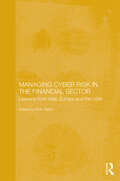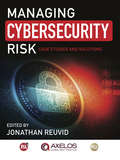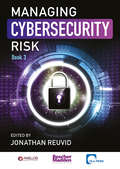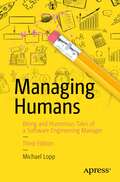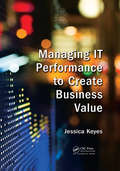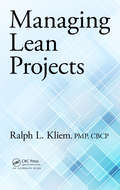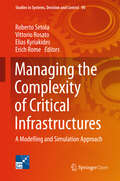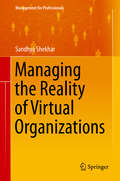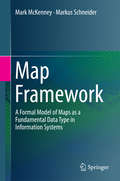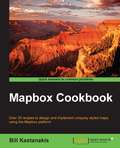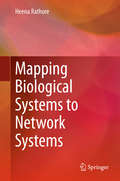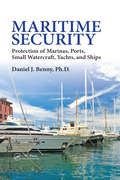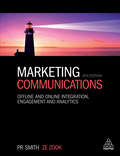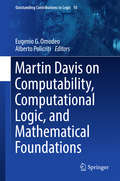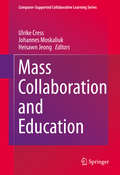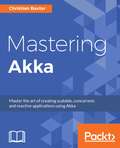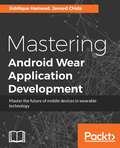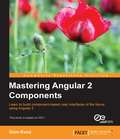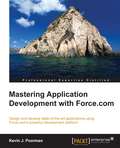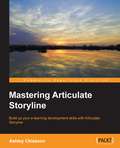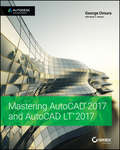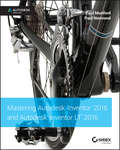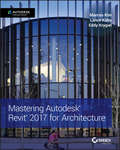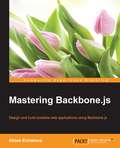- Table View
- List View
Managing Cyber Risk in the Financial Sector: Lessons from Asia, Europe and the USA (Routledge Studies in the Growth Economies of Asia)
by Ruth TaplinCyber risk has become increasingly reported as a major problem for financial sector businesses. It takes many forms including fraud for purely monetary gain, hacking by people hostile to a company causing business interruption or damage to reputation, theft by criminals or malicious individuals of the very large amounts of customer information (“big data”) held by many companies, misuse including accidental misuse or lack of use of such data, loss of key intellectual property, and the theft of health and medical data which can have a profound effect on the insurance sector. This book assesses the major cyber risks to businesses and discusses how they can be managed and the risks reduced. It includes case studies of the situation in different financial sectors and countries in relation to East Asia, Europe and the United States. It takes an interdisciplinary approach assessing cyber risks and management solutions from an economic, management risk, legal, security intelligence, insurance, banking and cultural perspective.
Managing Cybersecurity Risk: Cases Studies and Solutions
by Jonathan ReuvidThe first edition, published November 2016, was targeted at the directors and senior managers of SMEs and larger organisations that have not yet paid sufficient attention to cybersecurity and possibly did not appreciate the scale or severity of permanent risk to their businesses. <P><P> The book was an important wake-up call and primer and proved a significant success, including wide global reach and diverse additional use of the chapter content through media outlets. <P><P> The new edition, targeted at a similar readership, will provide more detailed information about the cybersecurity environment and specific threats. It will offer advice on the resources available to build defences and the selection of tools and managed services to achieve enhanced security at acceptable cost. A content sharing partnership has been agreed with major technology provider Alien Vault and the 2017 edition will be a larger book of approximately 250 pages.
Managing Cybersecurity Risk: Book 3
by Jonathan ReuvidCybersecurity is the practice of protecting systems, networks and programs from digital attacks. These attacks are usually aimed at accessing, changing or destroying sensitive information, extorting money from users or interrupting normal business processes.This new edition will provide valuable information on the cyber environment and threats that businesses may encounter. Such is the scale and variety of cyber threats, it is essential to recognise issues such as gaps in the workforce and the skills required to combat them. The guide also addresses the social and financial impacts of cyber breaches and the development of cyber protection for the future.Offering understanding and advice the book covers topics such as the following, all from key speakers and industry experts:TrainingTechnology trendsNew theoriesCurrent approachesTactical risk managementStories of human errors and their resultsManaging Cybersecurity Risk is an essential read for all businesses, whether large or small.With a Foreword by Don Randall, former head of Security and CISO, the Bank of England, contributors include Vijay Rathour, Grant Thornton and Digital Forensics Group, Nick Wilding, General Manager of Cyber Resilience at Axelos, IASME Consortium Ltd, CyberCare UK, DLA Piper, CYBERAWARE and more.
Managing Humans: Biting and Humorous Tales of a Software Engineering Manager
by Michael LoppRead hilarious stories with serious lessons that Michael Lopp extracts from his varied and sometimes bizarre experiences as a manager at Apple, Pinterest, Palantir, Netscape, Symantec, Slack, and Borland. Many of the stories first appeared in primitive form in Lopp’s perennially popular blog, Rands in Repose. The Third Edition of Managing Humans contains a whole new season of episodes from the ongoing saga of Lopp's adventures in Silicon Valley, together with classic episodes remastered for high fidelity and freshness.Whether you're an aspiring manager, a current manager, or just wondering what the heck a manager does all day, there is a story in this book that will speak to you—and help you survive and prosper amid the general craziness of dysfunctional bright people caught up in the chase of riches and power. Scattered in repose among these manic misfits are managers, an even stranger breed of people who, through a mystical organizational ritual, have been given power over the futures and the bank accounts of many others.Lopp's straight-from-the-hip style is unlike that of any other writer on management and leadership. He pulls no punches and tells stories he probably shouldn't. But they are magically instructive and yield Lopp’s trenchant insights on leadership that cut to the heart of the matter—whether it's dealing with your boss, handling a slacker, hiring top guns, or seeing a knotty project through to completion.Writing code is easy. Managing humans is not. You need a book to help you do it, and this is it.What You'll LearnLead engineersHandle conflictHire wellMotivate employeesManage your bossDiscover how to say noUnderstand different engineering personalitiesBuild effective teamsRun a meeting wellScale teamsWho This Book Is ForManagers and would-be managers staring at the role of a manager wondering why they would ever leave the safe world of bits and bytes for the messy world of managing humans. The book covers handling conflict, managing wildly differing personality types, infusing innovation into insane product schedules, and figuring out how to build a lasting and useful engineering culture.
Managing IT Performance to Create Business Value
by Jessica KeyesManaging IT Performance to Create Business Value provides examples, case histories, and current research for critical business issues such as performance measurement and management, continuous process improvement, knowledge management, risk management, benchmarking, metrics selection, and people management. It gives IT executives strategies for improving IT performance and delivering value, plus it guides them in selecting the right metrics for their IT organizations. Additionally, it offers knowledge management strategies to mature an organization, shows how to manage risks to exploit opportunities and prepare for threats, and explains how to baseline an IT organization’s performance and measure its improvement. <P><P>Consisting of 10 chapters plus appendices, the book begins with an overview of performance-based strategic planning, after which it discusses the development of a quality improvement (QI) plan, establishing benchmarks, and measuring performance improvements. It covers how to design IT-specific measures and financial metrics as well as the establishment of a software measurement program. From there, it moves on to designing people improvement systems and discusses such topics as leadership, motivation, recruitment, and employee appraisal. <P><P>The final few chapters show how to use balanced scorecards to manage and measure knowledge-based social enterprising and to identify, analyze, and avoid risks. In addition to covering new methods and metrics for measuring and improving IT processes, the author looks at strategies for measuring product development and implementing continuous innovation. The final chapter considers customer value systems and explains how to use force field analysis to listen to customers with the goal of improving customer satisfaction and operational excellence.
Managing Lean Projects
by Ralph L. KliemLean is a set of disciplines that can result in tremendous savings and profitability for companies. It can significantly reduce cycle times and increase customer satisfaction. Lean, however, must be applied efficiently and effectively to achieve optimum results. This book discusses project management concepts, tools, and techniques as they apply to
Managing the Complexity of Critical Infrastructures
by Roberto Setola Vittorio Rosato Elias Kyriakides Erich RomeThis book is open access under a CC BY 4. 0 license. This book summarizes work being pursued in the context of the CIPRNet (Critical Infrastructure Preparedness and Resilience Research Network) research project, co-funded by the European Union under the Seventh Framework Programme (FP7). The project is intended to provide concrete and on-going support to the Critical Infrastructure Protection (CIP) research communities, enhancing their preparedness for CI-related emergencies, while also providing expertise and technologies for other stakeholders to promote their understanding and mitigation of the consequences of CI disruptions, leading to enhanced resilience. The book collects the tutorial material developed by the authors for several courses on the modelling, simulation and analysis of CIs, representing extensive and integrated CIP expertise. It will help CI stakeholders, CI operators and civil protection authorities understand the complex system of CIs, and help them adapt to these changes and threats in order to be as prepared as possible for mitigating emergencies and crises affecting or arising from CIs.
Managing the Reality of Virtual Organizations
by Sandhya ShekharThis book comes at a time when virtual organizations(VO), are proliferating exponentially due to the twin catalysts ofglobalization and technological enablement. It provides conceptual frameworksand simple tools for identifying and addressing the complexities of managinggeographically dispersed, virtually linked organizations, which may have grownorganically or inorganically into a potpourri of multiple cultures,capabilities and practices. These can help to scientifically assess the impactof virtualization, balance the physical with the virtual and manage risks usingearly indicators. The book provides mechanisms to recognize, localize, measureand address vulnerabilities. Ensuring knowledge transfer effectiveness (KTE) isvital in VOs. A diagnostic tool has been evolved to measure KTE, isolateproblems and weak links and plan effective interventions. A set of criticalfactors to increase the probability of success of globalization strategies havebeen identified. This book interleaves theory with practice and providesinsights drawn from conversations with business leaders, exploratory surveys,and in-depth research using a large sample. The solid methodologicalunderpinnings serve as a useful template for researchers, while the models canbe contextualized to suit any organization. Foreword by Mr. Ajit Balakrishnan, Chairman and CEO, Rediff. com;Chairman, Board of Governors, Indian Institute of Management Calcutta.
Map Framework
by Mark Mckenney Markus SchneiderThis book explores the concept of a map as a fundamental data type. It defines maps at three levels. The first is an abstract level, in which mathematic concepts are leveraged to precisely explain maps and operational semantics. The second is at a discrete level, in which graph theory is used to create a data model with the goal of implementation in computer systems. Finally, maps are examined at an implementation level, in which the authors discuss the implementation of a fundamental map data type in database systems. The map data type presented in this book creates new mechanisms for the storage, analysis, and computation of map data objects in any field that represents data in a map form. The authors develop a model that includes a map data type capable of representing thematic and geometric attributes in a single data object. The book provides a complete example of mathematically defining a data type, ensuring closure properties of those operations, and then translating that type into a state that is suited for implementation in a particular context. The book is designed for researchers and professionals working in geography or computer science in a range of fields including navigation, reasoning, robotics, geospatial analysis, data management, and information retrieval.
Mapbox Cookbook
by Bill KastanakisOver 35 recipes to design and implement uniquely styled maps using the Mapbox platform About This Book * Design and develop beautifully styled maps using TileMill, MapBox Studio, and CartoCSS * Get to grips with the mapbox.js and Leaflet to create visually stunning web and mobile applications * An easy-to-follow, quick reference guide to integrate powerful APIs and services like Foursquare, Fusion Tables, Geoserver, and CartoDB to populate your maps Who This Book Is For If you are a web developer seeking for GIS expertise on how to create, style, and publish interactive and unique styled maps, then this book is for you. Basic knowledge of programming and javascripts is assumed. What You Will Learn * Get accustomed to the MapBox Editor to visually style your maps * Learn everything about CartoCSS, and how it will help you fine tune your styled maps * Use MapBox Studio and Tilemill to generate your own tiles and vector maps * Publish your maps using a variety of technologies like node.js, PHP, and Geoserver * Integrate with third party APIs and services to populate your maps with public or private data * Create many different map visualization styles like choropleth and heat maps, add interactivity, and even learn how to animate data over time * Work with many different data formats and external services to create robust maps * Learn to use MapBox GL to create a mobile application In Detail Maps are an essential element in today's location aware applications. Right from displaying earth surface information to creating thematic maps displaying plethora of information, most of the developers lack the necessary knowledge to create customizable maps with combination of various tools and libraries. The MapBox platform is one such platform which offers all the tools and API required to create and publish a totally customizable map. Starting with building your first map with the online MapBox Editor, we will take you all the way to building advanced web and mobile applications with totally customizable map styles. Through the course of chapters we'll learn CartoCSS styling language and understand the various components of MapBox platform and their corresponding JavaScript API. In the initial few chapters we will dive deeper into the TileMill and MapBox Studio components of MapBox and use them to generate custom styled map tiles and vector maps. Furthermore, we will publish these custom maps using PHP, node.js and third party tools like Geoserver. We'll also learn to create different visualizations and map styles like a choropleth map, a heat map and add user interactivity using a UFTGrid. Moving on, we dive into advanced concepts and focus on integration with third party services like Foursquare, Google FusionTables, CartoDB, and Torque to help you populate and even animate your maps. In the final chapter we'll learn to use the Mapbox SDK to create and publish interactive maps for the iOS platform. By the end of this book, you will learn about MapBox GL and how to create a fully functional, location-aware mobile app, using the maps styles created in the recipes. Style and approach An easy-to-use recipe driven book that will not just serve code samples, but also explains all the theory and concepts required to fully understand each recipe.
Mapping Biological Systems to Network Systems
by Heena RathoreThebook presents the challenges inherent in the paradigm shift of network systemsfrom static to highly dynamic distributed systems - it proposes solutions thatthe symbiotic nature of biological systems can provide into altering networkingsystems to adapt to these changes. The author discuss how biological systems -which have the inherent capabilities of evolving, self-organizing,self-repairing and flourishing with time - are inspiring researchers to takeopportunities from the biology domain and map them with the problems faced innetwork domain. The book revolves around the central idea of bio-inspiredsystems -- it begins by exploring why biology and computer network research aresuch a natural match. This is followed by presenting a broad overview ofbiologically inspired research in network systems -- it is classified by thebiological field that inspired each topic and by the area of networking inwhich that topic lies. Each case elucidates how biological concepts havebeen most successfully applied in various domains. Nevertheless, it alsopresents a case study discussing the security aspects of wireless sensornetworks and how biological solution stand out in comparison to optimizedsolutions. Furthermore, it also discusses novel biological solutions forsolving problems in diverse engineering domains such as mechanical, electrical,civil, aerospace, energy and agriculture. The readers will not only get properunderstanding of the bio inspired systems but also better insight fordeveloping novel bio inspired solutions.
Mapping Experiences: A Guide to Creating Value through Journeys, Blueprints, and Diagrams
by James KalbachCustomers who have inconsistent, broken experiences with products and services are understandably frustrated. But it's worse when people inside these companies can't pinpoint the problem because they're too focused on business processes. This practical book shows your company how to use alignment diagrams to turn valuable customer observations into actionable insight. With this unique tool, you can visually map your existing customer experience and envision future solutions.Product and brand managers, marketing specialists, and business owners will learn how experience diagramming can help determine where business goals and customer perspectives intersect. Once you're armed with this data, you can provide users with real value.Mapping Experiences is divided into three parts:Understand the underlying principles of diagramming, and discover how these diagrams can inform strategyLearn how to create diagrams with the four iterative modes in the mapping process: setting up a mapping initiative, investigating the evidence, visualizing the process, and using diagrams in workshops and experimentsSee key diagrams in action, including service blueprints, customer journey maps, experience maps, mental models, and spatial maps and ecosystem models
Maritime Security: Protection of Marinas, Ports, Small Watercraft, Yachts, and Ships
by Ph.D, Daniel BennyIn a time when threats against the maritime community have never been greater, Maritime Security: Protection of Marinas, Ports, Small Watercraft, Yachts, and Ships provides a single, comprehensive source of necessary information for understanding and preventing or reducing threats to the maritime community.The book defines what comprises the mariti
Marketing Communications
by Ze Zook Pr SmithMarketing Communications provides a comprehensive overview of every aspect of marketing communications, from social media, advertising, PR and sponsorship to direct selling and merchandizing. It presents modern marketing communications theories and tools in an accessible way so readers can fully understand the landscape and achieve better results. With a plethora of examples and case studies, as well as online support material for lecturers and students, this essential textbook will guide students and practitioners through everything they need to know about the changing face of marketing. This fully updated 6th edition of Marketing Communications features more of the underpinning theory whilst building on its impressive reputation as a leading practical textbook on the subject. Case studies and anecdotes from companies such as Campbell's Soup, Spotify, Paypal, Kraft and Nike focus on recent digital developments to bring the latest marketing tools to life. With a particular emphasis on analytics, engagement and integration, it addresses the integrated offline and online with social media approach to reflect the current state of play for marketing communications experts.
Martin Davis on Computability, Computational Logic, and Mathematical Foundations
by Eugenio G. Omodeo Alberto PolicritiThis book presents a set of historical recollections on the work of Martin Davis and his role in advancing our understanding of the connections between logic, computing, and unsolvability. The individual contributions touch on most of the core aspects of Davis' work and set it in a contemporary context. They analyse, discuss and develop many of the ideas and concepts that Davis put forward, including such issues as contemporary satisfiability solvers, essential unification, quantum computing and generalisations of Hilbert's tenth problem. The book starts out with a scientific autobiography by Davis, and ends with his responses to comments included in the contributions. In addition, it includes two previously unpublished original historical papers in which Davis and Putnam investigate the decidable and the undecidable side of Logic, as well as a full bibliography of Davis' work. As a whole, this book shows how Davis' scientific work lies at the intersection of computability, theoretical computer science, foundations of mathematics, and philosophy, and draws its unifying vision from his deep involvement in Logic.
Mass Collaboration and Education
by Ulrike Cress Johannes Moskaliuk Heisawn JeongMass collaboration on Internet platforms like Wikipedia and Scratch, along with wider movements like the maker space and citizen science, are poised to have profound impacts on learning and education. Bringing together researchers from such fields as: psychology, education, information technology, and economics, the book offers a comprehensive overview of mass collaboration, novel, cross disciplinary, theoretical accounts, and methodological approaches for studying and improving these massively collaborative enterprises. The book is aimed to serve as an information source for researchers, educators, and designers of platforms and learning environments.
Mastering Akka
by Christian BaxterMaster the art of creating scalable, concurrent, and reactive applications using Akka About This Book * This book will help you cure anemic models with domain-driven design * We cover major Akka programming concepts such as concurrency, scalability, and reactivity * You will learn concepts like Event Sourcing and CQRS via Akka Persistence, Akka Streams, Akka Http as well as Akka Clustering Who This Book Is For If you want to use the Lightbend platform to create highly performant reactive applications, then this book is for you. If you are a Scala developer looking for techniques to use all features of the new Akka release and want to incorporate these solutions in your current or new projects, then this book is for you. Expert Java developers who want to build scalable, concurrent, and reactive application will find this book helpful. What You Will Learn * Use Akka actors to enable parallel execution * Build out domain-driven design based components like entities and aggregates * Respond to command requests on that aggregate root that affect the internal state * Leverage Akka Persistence, protobuf and Cassandra to save the persistent state of you entities * Build out complex processing graphs with the Graph Builder DSL * Understand the dynamic push/pull nature of backpressure handling within Akka Streams * Route HTTP requests to an actor and return a response * Deploy actor instances across a set of nodes via ConductR for high availability In Detail For a programmer, writing multi-threaded applications is critical as it is important to break large tasks into smaller ones and run them simultaneously. Akka is a distributed computing toolkit that uses the abstraction of the Actor model, enabling developers to build correct, concurrent, and distributed applications using Java and Scala with ease. The book begins with a quick introduction that simplifies concurrent programming with actors. We then proceed to master all aspects of domain-driven design. We'll teach you how to scale out with Akka Remoting/Clustering. Finally, we introduce Conductr as a means to deploy to and manage microservices across a cluster. Style and approach This comprehensive, fast-paced guide is packed with several real-world use cases that will help you understand concepts, issues, and resolutions while using Akka to create highly performant, scalable, and concurrency-proof reactive applications.
Mastering Android Wear Application Development
by Siddique Hameed Javeed ChidaMaster the future of mobile devices in wearable technology About This Book * Mastering Android Wear Development is a complete guide to wearable technology for experienced Android developers * Notifications, voice input, coping with round screens - all the key challenges of wearable technology are covered * This book describes not just how to write code for wearables, but also how to think about wearable technology and design apps that work well with the physical limitations of wearable devices Who This Book Is For This book is for application developers (the web, mobile, and desktop) who are interested in building new wearable apps, and mobile developers who already have apps on iTunes or Google Play Store and are looking to provide Android Wear support for their existing Android or iOS apps. What You Will Learn * Understand the Wearable computing technology * Set up a development environment to build Android Wear apps using Android Studio * Master the Android Wear SDK and APIs * Understand the UI patterns and UX principles to build Android Wear apps * Work with the different form factors of wearable devices (round and square) * Take advantage of the sensors available on Android Wear devices * Develop Android Wear sample apps * Communicate between Android mobile and Android Wear apps * Get to know the steps involved in publishing Android Wear apps to the Play store In Detail Wearable technology is the future of mobile devices. It looks set to be a breakthrough technology, just like the iPad was before it. With the Apple Watch being widely regarded as a success, all eyes are now on Google to provide a similar device for its users. Keep your skills ahead of the competition and be one of the first to fully understand this powerful new trend. This book will give you a very solid understanding of the philosophy, thought process, development details, and methodologies involved in building well-designed, robust Android Wear applications. We cover the advantages and disadvantages of the wearable computing paradigm and provide a good foundational knowledge for you to build practical, real-world wearable apps. You will learn about the various tools, platforms, libraries, SDKs, and technology needed to build Android Wear apps. By the end of the book, you will be an expert in building Android wearable apps. Style and approach This one-stop professional tutorial will teach you everything you need to know to begin designing and developing applications for this exciting new technology. Every step from development through testing to deployment is explained in depth.
Mastering Angular 2 Components
by Gion KunzLearn to build component-based user interfaces of the future using Angular 2 About This Book * Developers will be able to make better websites right away by building the example components in the book * You'll learn new ways of conceptualizing how to design your web applications, which will prepare you to keep making more sophisticated projects * Learning these concepts and building these apps will put developers ahead of the curve in preparing for "tomorrow's Internet," as component-based development and component-centric thinking are increasingly in demand Who This Book Is For This book is for Angular developers who already have a good understanding of basic frontend web technologies such as JavaScript, HTML, and CSS. You will learn about the new component-based architecture in Angular 2 and how to use it to build modern and clean user interfaces. What You Will Learn * Understand the concept of a component-based UI architecture * Grasp Angular 2 core concepts * See the technologies used to work with Angular 2 (mainly ES6) * Perform basic and advanced tasks using Angular 2 components * Use dependency injection within Angular 2 components * Test Angular 2 components with testing frameworks * Structure an application using Angular 2 * Build an entire application from A to Z using Angular 2 In Detail Through this book, you will learn how to use Angular 2 and its component-based architecture in order to develop modern user interfaces. A new holistic way of thinking about UI development will be established throughout this book, and you will discover the power of Angular 2 components through many examples. This book is based on Release Candidate 1(RC1) of Angular 2. On this journey, you'll discover the benefits of component-based user interfaces over the classical MVC design. Also, you will get a chance to compare a classical MVC with a component-based approach and understand the challenges of modern user interfaces. You will learn the very basics of the required core technologies and the setup needed to get going with Angular 2, and progressively enhance your understanding of Angular 2 components by working on the example application. After reading the book and following the example application, you will have built a small-to-mid-sized application with Angular 2 using a component-based UI architecture. Style and approach The new component-style directives in Angular 2 will change developers' workflows and their way of thinking about shared and reusable blocks of custom HTML in the shadow DOM. This is the first book to guide developers along this path. It provides a practical way of learning concepts, giving you the chance to build components of your own. With this book, you will get ahead of the curve in a new wave of web development by tightly focusing on one area, which is the key to unlocking the powers of Angular development.
Mastering Application Development with Force.com
by Kevin J. PoormanDesign and develop state-of-the-art applications using Force.com's powerful development platform About This Book * Flaunt your skillsets by developing complex applications that include demanding concepts such as triggers, Visualforce controllers, batch jobs, and Lightning components * Earn the gratitude of your colleagues by structuring a project so that multiple developers can work independently of each other * Kevin Poorman, the author of the book and a Force.com MVP, shares his years of Force.com knowledge and experience with you through the medium of telling examples Who This Book Is For If you're a Force.com developer with a fundamental understanding of Apex and JavaScript but now want to enhance your skills with tips, tricks, and guidance on the best architectural and engineering practices, then this book is for you. What You Will Learn * Creating triggers, and the best practices for writing them * Developing a number of Visualforce controllers and extensions * Integrating third-party web APIs into your Apex code * Writing unit tests that cover testing bulk safety, user and profile settings, and negative tests * Creating a Lightning component for use in Salesforce1 * Getting acquainted with various methods for deploying metadata between orgs * Using the Rest sObject API for access to Salesforce objects and data using the REST methodology * Learning about overarching architectural considerations such as naming conventions, testing practices, and data modeling practices In Detail Force.com is an extremely powerful, scalable, and secure cloud platform, delivering a complete technology stack, ranging from databases and security to workflow and the user interface. With salesforce.com's Force.com cloud platform, you can build any business application and run it on your servers. The book will help you enhance your skillset and develop complex applications using Force.com. It gets you started with a quick refresher of Force.com's development tools and methodologies, and moves to an in-depth discussion of triggers, bulkification, DML order of operations, and trigger frameworks. Next, you will learn to use batchable and schedulable interfaces to process massive amounts of information asynchronously. You will also be introduced to Salesforce Lightning and cover components--including backend (apex) controllers, frontend (JavaScript) controllers, events, and attributes--in detail. Moving on, the book will focus on testing various apex components: what to test, when to write the tests, and--most importantly--how to test. Next, you will develop a changeset and use it to migrate your code from one org to another, and learn what other tools are out there for deploying metadata. You will also use command-line tools to authenticate and access the Force.com Rest sObject API and the Bulk sObject API; additionally, you will write a custom Rest endpoint, and learn how to structure a project so that multiple developers can work independently of each other without causing metadata conflicts. Finally, you will take an in-depth look at the overarching best practices for architecture (structure) and engineering (code) applications on the Force.com platform. Style and approach A step-by-step tutorial, with plenty of tips and tricks that will help you develop complex Force.com applications.
Mastering Articulate Storyline
by Ashley ChiassonBuild up your e-learning development skills with Articulate Storyline About This Book * Develop interactive e-learning projects using advanced techniques * Impress your clients and/or audience with out-of-the-box interactions * Step-by-step walkthroughs provide practical solutions Who This Book Is For This book is for anyone experienced in using the basic functions of Articulate Storyline who are yearning to learn more. It's designed to provide a brief overview of key concepts, to help you refresh your knowledge of common functions, and teach you how to push Storyline to the limit! What You Will Learn * Familiarize yourself with best practices for e-learning development * Review key Storyline concepts before diving in deep with development * Discover new ways of working within Storyline to extend slide content and enhance interactivity * Personalize your story with advanced variable-based interactions * See how JavaScript can be used in your stories to do some really neat things * Assess your learners using customized assessment options and find out how to troubleshoot common issues * Customize the learning experience by modifying the player properties and publishing settings * Customize your story and prepare it for publishing In Detail Storyline is a powerful e-learning authoring tool that allows you to take your creativity to the next level. However, more often than not, projects don't require such complex interactions, leaving Storyline's full capabilities untapped. This book will provide you with the information you need to take your Storyline development up a notch by leveraging the full suite of possibilities Storyline has to offer. You will be provided with a refresher of the key concepts before we take you deep into the exciting world of enhanced interactivity, variables, and even some JavaScript--oh my! With downloadable activities, you can either follow along and compare your output, use the activities as they are, modify the activities to suit your own needs, or reverse-engineer the activities to better understand how they were developed. Style and approach You'll get hands-on working with project files that were created with you in mind. As you move through each chapters, the practical, step-by-step approach will get you using some of the more advanced features of Storyline to create polished and snazzy interactions.
Mastering AutoCAD 2017 and AutoCAD LT 2017
by George Omura Brian C. BentonThe bestselling guide to AutoCAD, updated and expanded for the AutoCAD 2017 release Mastering AutoCAD 2017 and AutoCAD LT 2017 is the premier guide to the world's leading CAD program. With clear explanation, focused examples, and step-by-step instruction, this guide walks you through everything you need to know to use AutoCAD 2017 and AutoCAD LT 2017 effectively. From basic drafting tools to 3D modeling, this book leaves no stone unturned in exploring the full repertoire of AutoCAD capabilities. Hands-on instruction allows for more productive learning, and provides clarification of crucial techniques. Effective as both a complete tutorial and a dip-in reference, the broadly-applicable concepts and instructions will appeal to AutoCAD users across industries and abilities. This new edition has been thoroughly updated to align with the software's latest features and capabilities, giving you a one-stop resource for getting up to speed. AutoCAD is the leading software for 2D and 3D technical drawings, and AutoCAD LT makes the software's tremendous functionality more accessible for smaller businesses and individuals. This guide shows you how to take full advantage of this powerful design platform, with expert guidance every step of the way. Get acquainted with the interface and master basic tools Utilize hatches, fields, cures, solid fills, dynamic blocks, and more Explore 3D modeling and imaging for more holistic design Customize the AutoCAD workflow to suit your needs Whether you're learning AutoCAD for the first time, upgrading from a previous version, or preparing for a certification exam, you need a thorough reference designed for the way professionals work. Mastering AutoCAD 2017 and AutoCAD LT 2017 is your ideal guide, with complete tutorials and expert advice.
Mastering Autodesk Inventor 2016 and Autodesk Inventor LT 2016: Autodesk Official Press
by Paul Munford Paul NormandYour real-world introduction to mechanical design with Autodesk Inventor 2016 Mastering Autodesk Inventor 2016 and Autodesk Inventor LT 2016 is a complete real-world reference and tutorial for those learning this mechanical design software. With straightforward explanations and practical tutorials, this guide brings you up to speed with Inventor in the context of real-world workflows and environments. You'll begin designing right away as you become acquainted with the interface and conventions, and then move into more complex projects as you learn sketching, modeling, assemblies, weldment design, functional design, documentation, visualization, simulation and analysis, and much more. Detailed discussions are reinforced with step-by-step tutorials, and the companion website provides downloadable project files that allow you to compare your work to the pros. Whether you're teaching yourself, teaching a class, or preparing for the Inventor certification exam, this is the guide you need to quickly gain confidence and real-world ability. Inventor's 2D and 3D design features integrate with process automation tools to help manufacturers create, manage, and share data. This detailed guide shows you the ins and outs of all aspects of the program, so you can jump right in and start designing with confidence. Sketch, model, and edit parts, then use them to build assemblies Create exploded views, flat sheet metal patterns, and more Boost productivity with data exchange and visualization tools Perform simulations and stress analysis before the prototyping stage This complete reference includes topics not covered elsewhere, including large assemblies, integrating other CAD data, effective modeling by industry, effective data sharing, and more. For a comprehensive, real-world guide to Inventor from a professional perspective, Mastering Autodesk Inventor 2016 and Autodesk Inventor LT 2016 is the easy-to-follow hands-on training you've been looking for.
Mastering Autodesk Revit 2017 for Architecture
by Marcus Kim Lance Kirby Eddy KrygielThe ultimate guide to Revit Architecture just got even better Mastering Autodesk Revit 2017 for Architecture is the bestselling guide for Revit Architecture users of all levels, with focused discussions, detailed exercises, and compelling real-world examples. This new edition has been completely revamped based on reader and Revit Architecture instructor feedback to be more useful, more complete, and more approachable than ever. Organized by real-world workflow, practical tutorials guide you through each phase of a project to help you understand BIM concepts and quickly start accomplishing vital Revit Architecture tasks. From templates, work-sharing, and project management, to modeling, documentation, annotation, and complex structures, this book provides full coverage of essential Revit Architecture tools and processes. The companion website features before-and-after tutorials, additional advanced content, and an hour of video instruction to help you quickly master crucial techniques. Learn up-to-date Revit Architecture workflows and processes Master modeling, massing, and other visualization techniques Work with complex structural elements and advanced detailing Prepare for Autodesk certification exams Building information modeling pairs the visual design representation with a parametric database that stores all geometry, spatial relationships, materials, and other data generated by the design process. Design changes instantly update all documentation, and it's this efficiency that makes BIM the new permanent paradigm. Whether you're studying for a certification exam or navigating the switch from CAD, Mastering Autodesk Revit 2017 for Architecture is your number-one guide to getting up and running quickly.
Mastering Backbone.js
by Abiee EchameaDesign and build scalable web applications using Backbone.jsAbout This BookLevel up your Backbone.js skills and create professional web applications with the best practicesUse the Backbone.js components in the right way and avoid maintenance nightmaresImprove your development workflow from application design to deploymentApply the best practices given in this tutorial to solve day-to-day problems in your applicationsWho This Book Is ForThis book is for those developers who know the basic concepts of Backbone.js and want to build scalable applications with it. If you are looking for the best practices of using Backbone.js applied to real work applications, this book is for you. You will be able to apply architectural principles to create amazing web applications easily.What You Will LearnBuild web applications that scale with Backbone.jsDesign a powerful architecture that eliminates maintenance nightmaresUse common patterns and best practices in Backbone.js web applications developmentsPack your applications to be deployed to production environmentsClean up your code organization to a simple and maintainable architectureTest your components and get confidence with your codeDeal with common scenarios like file uploading and login issuesIn DetailBackbone.js is a popular library to build single page applications used by many start-ups around the world because of its flexibility, robustness and simplicity. It allows you to bring your own tools and libraries to make amazing webapps with your own rules. However, due to its flexibility it is not always easy to create scalable applications with it. By learning the best practices and project organization you will be able to create maintainable and scalable web applications with Backbone.js.With this book you will start right from organizing your Backbone.js application to learn where to put each module and how to wire them. From organizing your code in a logical and physical way, you will go on to delimit view responsibilities and work with complex layouts.Synchronizing models in a two-way binding can be difficult and with sub resources attached it can be even worse. The next chapter will explain strategies for how to deal with these models. The following chapters will help you to manage module dependencies on your projects, explore strategies to upload files to a RESTful API and store information directly in the browser for using it with Backbone.js. After testing your application, you are ready to deploy it to your production environment. The final chapter will cover different flavors of authorization.The Backbone.js library can be difficult to master, but in this book you will get the necessary skill set to create applications with it, and you will be able to use any other library you want in your stack.Style and approachThis book takes a tutorial approach to help you scale your Backbone.js applications. It builds a web application using the best practices and applies architectural design principles to develop maintainable web-apps. Each chapter explains the design decisions and improves the project that is used as an example alongside the book.
